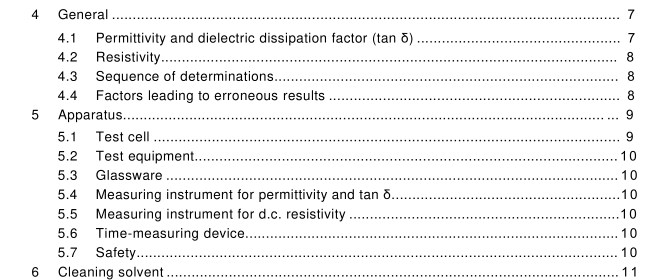BS EN 60247:2004 – Insulating liquids — Measurement of relative permittivity, dielectric dissipation factor (tan $) and d.c. resistivity

1 Scope This International standard describes methods for the determination of the dielectric dissipation factor (tan δ), relative permittivity and d.c. resistivity of any insulating liquid material at the test temperature.
The methods are primarily intended for making reference tests on unused liquids. They can also be applied to liquids in service in transformers, cables and other electrical apparatus.
However the method is applicable to a single phase liquid only. When it is desired to make routine determinations, simplified procedures, as described in Annex C, may be adopted. With insulating liquids other than hydrocarbons, alternative cleaning procedures may be required.
2 Normative references
The following referenced documents are indispensable for the application of this document. For dated references, only the edition cited applies. For undated references, the latest edition of the referenced document (including any amendments) applies. IEC 60093, Methods of test for volume resistivity and surface resistivity of solid electrical insulating materials
IEC 60250, Recommended methods for the determination of the permittivity and dielectric dissipation factor of electrical insulating materials at power, audio and radio frequencies including metre wavelengths IEC 60475, Method of sampling liquid dielectrics IEC 61 620, Insulating liquids – Determination of the dielectric dissipation factor by measure- ment of the conductance and capacitance – Test method 3 Terms and definitions For the purposes of this document, the following terms and definitions apply.
3.1 permittivity (relative) the relative permittivity of an insulating material is the ratio of capacitance C x of a capacitor in which the space between and around the electrodes is entirely and exclusively filled with the insulating material in question, to the capacitance C o of the same configuration of electrodes in vacuum. The capacitance C a of the configuration of electrodes in air can normally be used instead of C o to determine the relative permittivity with sufficient accuracy
4 General Permittivity, tan δ and resistivity, either separately or together, are important indicators of the intrinsic quality and degree of contamination of an insulating fluid. These parameters may be used to interpret the deviation from desired dielectric characteristics and the potential influence on performance of equipment in which the fluid is used.
4.1 Permittivity and dielectric dissipation factor (tan δ) The permittivity and the dielectric dissipation factor (tan δ) of electrical insulating liquids depend to a considerable extent on the test conditions under which they are measured, in particular on the temperature and on the frequency of the applied voltage. Permittivity and dissipation factor are the measurements of dielectric polarization and conductivity of the material.
At power frequency and sufficiently high temperature, as recommended in these methods, the losses may be attributable exclusively to the conductivity of the liquid, that is, to the presence of free charge carriers in the liquid. Measurements of the dielectric properties of high purity insulating liquids are therefore of value as an indication of the presence of contaminants.
BS EN 60247:2004 – Insulating liquids — Measurement of relative permittivity, dielectric dissipation factor (tan $) and d.c. resistivity